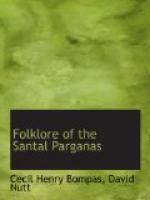Rahar. A cultivated crop, a kind of pulse.
Raibar. A marriage go-between, a man employed to arrange a marriage.
Rakas. An ogre. Sanskrit Rakhshya.
Rum. To be possessed, to fall into a cataleptic state.
Sabai. A kind of grass used for making rope.
Sal. A forest tree. Shorea robusta.
Seer. A weight, about two pounds.
Sid atang. To take the final step, to be completely initiated.
Sing bonga. The Sun god.
Sipahi. An armed guard, a soldier, armed messenger.
Sohrai. The great winter festival of the Santals.
Taluq. A revenue division of the country.
Tarop tree. A small tree, Buchanania latifolia.
Thakur. The supreme Being.
Tika. A mark on the forehead, the giving of which corresponds to coronation.
Tola. A hamlet, a detached quarter of a village.
Appendix
Introduction.
The Kolhan forms the western half of the district of Singhbhum in Chota Nagpur. The Hos or Larka Hos who form the bulk of the inhabitants are a branch of the Mundas of the Chota Nagpur Plateau. They are one of those Kolarian tribes of which the Santals are perhaps the best known. I have collected some of the Folklore stories current among them, the recollection of which would, however, appear to be dying out.
The Rev. A. Campbell of the Free Church of Scotland, Santal Mission, has printed a volume of Santal Folk Tales collected by him in Manbhum, a neighbouring district to Singhbhum. As might be expected there is considerable resemblance between those Santal Tales and the ones now reproduced. I have heard some of Mr. Campbell’s Santal stories told by Hos precisely as he relates them, and there are many incidents common to both collections. On the other hand there is no resemblance between these Kolarian tales, and the Bengal stories published by Rev. Lal Behari De. In the latter I only notice one incident which appears in the Kolhan stories, the bringing together of two lovers through a long hair floating down a stream, but in Bengal it is the lady’s hair that floats to her lover, while in the Kolhan it is always the long hair of the hero which inspires love in the heart of the Raja’s daughter.
The stories may be divided into two groups, the animal stories in which the principal characters are animals, for the most part denizens of the jungles, and the stories which deal with a settled state of Society with Rajas, priests and members of the different Hindu castes following their usual occupations. It is interesting, but perhaps scarcely profitable, to try and deduce from the latter some hints of the previous history of the Hos, who, as we know them, are a strongly democratic race, with a well developed tribal system. They look on themselves as the owners, of the soil and are unwilling to admit the claims of any overlord.




